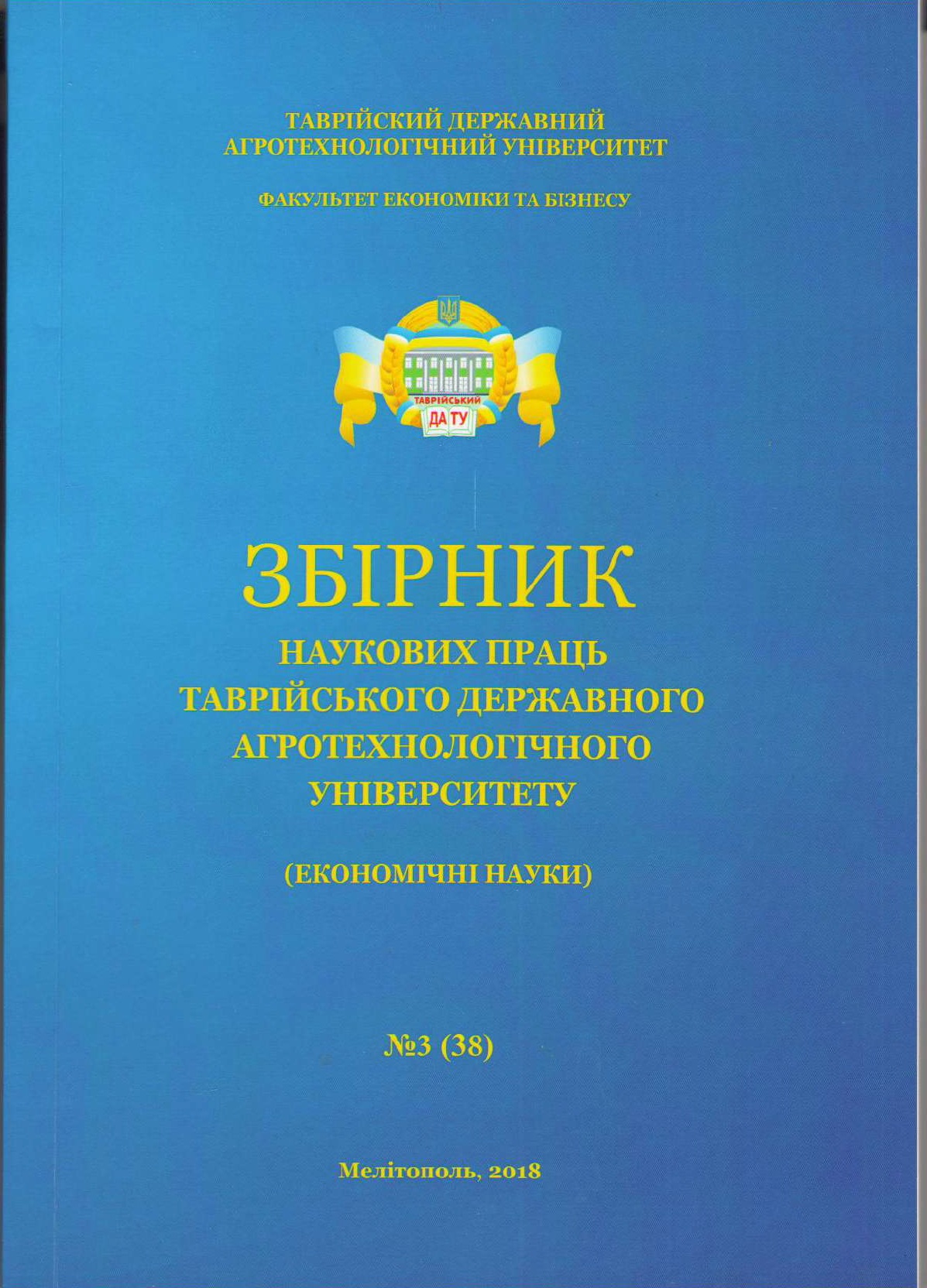СОЦІАЛЬНО-ЕКОНОМІЧНА ЕФЕКТИВНІСТЬ РОЗВИТКУ КОНВЕРГЕНЦІЇ ТЕХНОЛОГІЙ АГРОПРОМИСЛОВОГО КОМПЛЕКСУ
Ключові слова:
конвергенція, нанотехнології, біотехнології, інформаційні технології, інновації, ефективність.
Анотація
Анотація. В статті досліджено можливості економічного розвитку агропромислового комплексу з врахуванням особливостей та прикладного застосування конвергентних технологій, що дозволять підняти и на якісно новий рівень соціальну сферу та життя населення. Окреслено теоретичне підґрунтя поняття NBIC-технологій, наведено тенденції впливу NBIC-конвергенції на суспільний устрій та визначено вплив конвергенції на прикладі розвитку агропромислового комплексу.
Посилання
1. Прайд В. Феномен NBIC-конвергенции: Реальность и ожидания. Философские науки, 1. 2008. С. 97–117. 2. Roco M.C., Bainbridge W.S. Converging technologies for improving human performance: integrating from the nanoscale. J. Nanopart. Res. 4(4): 2002. р. 281–295. 3. Roco M.C., Bainbridge W.S. (Еds.) Managing Nano-Bio-Info-Cogno Innovations: Converging technologies in society, Springer, Berlin. 2006.
4. Roco M.C., Bainbridge W.S. (Еds.) Converging Technologies for Improving Human Performance: Nanotechnology, Biotechnology, Information Technology and the Cognitive Science. National Science Foundation. Arlington, VA. 2002.
5. Swierstra T., Boenink M., Walhout B., van Est R. (2009) Converging technologies, shifting boundaries. Nanoethics, 3(3): 2009. р. 213–216.
6. Schummer J. (2008) From nano-convergence to NBIC-convergence: «The best way to predict the future is to create it». In: S. Maasen, M. Kaiser, M. Kurath, C. Rehmann-Sutter (eds.) Deliberating Future Technologies: Identity, Ethics, and Governance of Nanotechnology. Springer. 2008.
7. Smalley R. Nanotechnology: the wet/dry frontier. Small Wonders Workshop. Washington DC.2002. 8. Roco M.C. Nanotechnology: convergence with modern biology and medicine. Curr. Opin. Biotechnol., 14(3): 2003. Р. 337–346. 9. Борисевич В.Б., Каплуненко В.Г. Наноматеріали в біології. Основи нановетеринарії. Авіцена, Киев, 2010. 415 c. 10. Ковальчук М. Направление прорыва. Технополис XXI, 19(3). 2009.: 4–7. 11. Баксанский О.Е., Гнатик Е.Н., Кучер Е.Н. Нанотехнологии, биомедицина, философия образования в зеркале ме-ждисциплинарного контекста, URSS, Москва, 2010. 224 с.
12. Державна служба статистики України. URL:http://www.ukrstat.gov.ua/
13. Газуда Леся Конвергенція людського і соціального капіталу територіальних економічних систем. проблеми і перспе-ктиви економіки та управління. № 1 (5), 2016. С.14-17
14. The Third Revolution: The Convergence of the Life Sciences, Physical Sciences and Engineeringю / MIT, 2011. January. 40 p. [Web resource]. link: http://dc.mit.edu/sites/dc.mit.edu/files/MIT%20White%20Paper%20on%20Convergence.pdf
15. Рифкин Дж. Третья промышленная революция: Как горизонтальные взаимодействия меняют энергетику, экономику и мир в целом.; Пер. с англ. М.: Альпина нон-фикшн, 2014. 410 с.
16. Draft Annual Work Programme 2013 for the ARTEMIS Programs / Advanced “Research and Technology for Embedded Intelligence and Systems (ARTEMIS)” of European Technology Platform for Embedded Computing Systems. London, 2013. January 16 [Web resource]. link : URL: http://www.artemis-ia.eu/call2013
17. The Changing Landscape of Disruptive Technologies 2018. URL: https://assets.kpmg.com/content/dam/kpmg/pl/pdf/2018/06/pl-The-Changing-Landscape-of-Disruptive-Technologies-2018.pdf
18. Матюшенко І.Ю. Технологічна конкурентоспроможність України в умовах нової промислової революції і розвитку конвергентних технологій. URL: http://oaji.net/articles/2016/728-1465390711.pdf
19. Матюшенко І.Ю. Теоретико-методичні засади розвитку конвергентних технологій для вирішення глобальних про-блем. Соціальна економіка. Випуск 54 (2) 2017 р.с.27-40.
20. Convergence of Knowledge, Technology and Society: Beyond Convergence of Nano-Bio-Info-Cognitive Technologies. Retrospective and outlook report. Summary of the 2011-2012 International CKTS Study/ M. C. Roco, W. S. Bainbridge, B. Tonn, G. Whitesides. – NSF/WTEC Science Policy Reports, 2013. 36 p. [Web resource] link : http://www.ntumems.net/About%20us/news /20150121/CTKS_Brochure.pdf
4. Roco M.C., Bainbridge W.S. (Еds.) Converging Technologies for Improving Human Performance: Nanotechnology, Biotechnology, Information Technology and the Cognitive Science. National Science Foundation. Arlington, VA. 2002.
5. Swierstra T., Boenink M., Walhout B., van Est R. (2009) Converging technologies, shifting boundaries. Nanoethics, 3(3): 2009. р. 213–216.
6. Schummer J. (2008) From nano-convergence to NBIC-convergence: «The best way to predict the future is to create it». In: S. Maasen, M. Kaiser, M. Kurath, C. Rehmann-Sutter (eds.) Deliberating Future Technologies: Identity, Ethics, and Governance of Nanotechnology. Springer. 2008.
7. Smalley R. Nanotechnology: the wet/dry frontier. Small Wonders Workshop. Washington DC.2002. 8. Roco M.C. Nanotechnology: convergence with modern biology and medicine. Curr. Opin. Biotechnol., 14(3): 2003. Р. 337–346. 9. Борисевич В.Б., Каплуненко В.Г. Наноматеріали в біології. Основи нановетеринарії. Авіцена, Киев, 2010. 415 c. 10. Ковальчук М. Направление прорыва. Технополис XXI, 19(3). 2009.: 4–7. 11. Баксанский О.Е., Гнатик Е.Н., Кучер Е.Н. Нанотехнологии, биомедицина, философия образования в зеркале ме-ждисциплинарного контекста, URSS, Москва, 2010. 224 с.
12. Державна служба статистики України. URL:http://www.ukrstat.gov.ua/
13. Газуда Леся Конвергенція людського і соціального капіталу територіальних економічних систем. проблеми і перспе-ктиви економіки та управління. № 1 (5), 2016. С.14-17
14. The Third Revolution: The Convergence of the Life Sciences, Physical Sciences and Engineeringю / MIT, 2011. January. 40 p. [Web resource]. link: http://dc.mit.edu/sites/dc.mit.edu/files/MIT%20White%20Paper%20on%20Convergence.pdf
15. Рифкин Дж. Третья промышленная революция: Как горизонтальные взаимодействия меняют энергетику, экономику и мир в целом.; Пер. с англ. М.: Альпина нон-фикшн, 2014. 410 с.
16. Draft Annual Work Programme 2013 for the ARTEMIS Programs / Advanced “Research and Technology for Embedded Intelligence and Systems (ARTEMIS)” of European Technology Platform for Embedded Computing Systems. London, 2013. January 16 [Web resource]. link : URL: http://www.artemis-ia.eu/call2013
17. The Changing Landscape of Disruptive Technologies 2018. URL: https://assets.kpmg.com/content/dam/kpmg/pl/pdf/2018/06/pl-The-Changing-Landscape-of-Disruptive-Technologies-2018.pdf
18. Матюшенко І.Ю. Технологічна конкурентоспроможність України в умовах нової промислової революції і розвитку конвергентних технологій. URL: http://oaji.net/articles/2016/728-1465390711.pdf
19. Матюшенко І.Ю. Теоретико-методичні засади розвитку конвергентних технологій для вирішення глобальних про-блем. Соціальна економіка. Випуск 54 (2) 2017 р.с.27-40.
20. Convergence of Knowledge, Technology and Society: Beyond Convergence of Nano-Bio-Info-Cognitive Technologies. Retrospective and outlook report. Summary of the 2011-2012 International CKTS Study/ M. C. Roco, W. S. Bainbridge, B. Tonn, G. Whitesides. – NSF/WTEC Science Policy Reports, 2013. 36 p. [Web resource] link : http://www.ntumems.net/About%20us/news /20150121/CTKS_Brochure.pdf
Опубліковано
2018-12-17

